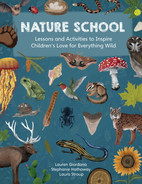Where the ocean biome meets land, there is the seashore. Our planet is covered in water, so seashores are abundant around the edges of continents and islands, both large and small, found throughout the world’s oceans. While all seashores are a combination of land and sea, they appear differently depending on their location and even the time of day.
Assorted colors and types of sand, varying sizes and shapes of pebbles and rocks, and the changing tides mean no two seashores look exactly the same. Whether waves pummel rocky ledges or the ocean gently laps a soft, sandy beach, seashores are brimming with life. Plants find a way to grow among the rocks and shifting sands, peppered constantly with salty spray. And hardy creatures tough it out in an ever-changing ecosystem.
As you explore the seashore in this chapter, you will discover the different types of beaches as well as the various parts that make up the beach. You will learn about the relentless waves and the dense salt water that makes them. You’ll study coastal landforms and how they are shaped through weathering and erosion. You will investigate the tides and their impact on wildlife. Your knowledge of sand dunes and seashore plants will grow, as will your understanding of the diverse creatures that make the seashore their home.
THE SEASHORE ECOSYSTEM
Seashores are dynamic ecosystems that border the edges of all continents and islands in between. Seashore ecosystems store and filter water, and trap sediment. Often, rocky and sandy beaches act as buffers when storms roll in, taking the brunt of the wind and punishing waves. The beach face is always changing as the water moves in and out.
The coast supplies ample areas for grasses and other vegetation to help secure sand and create valuable dune areas. And animals like sea turtles, marine mammals, birds, crabs, clams, fish, octopuses, sea stars, and others use shores and the surrounding areas as feeding, nesting, and nursery sites, as well as homes.
Anatomy of a Beach


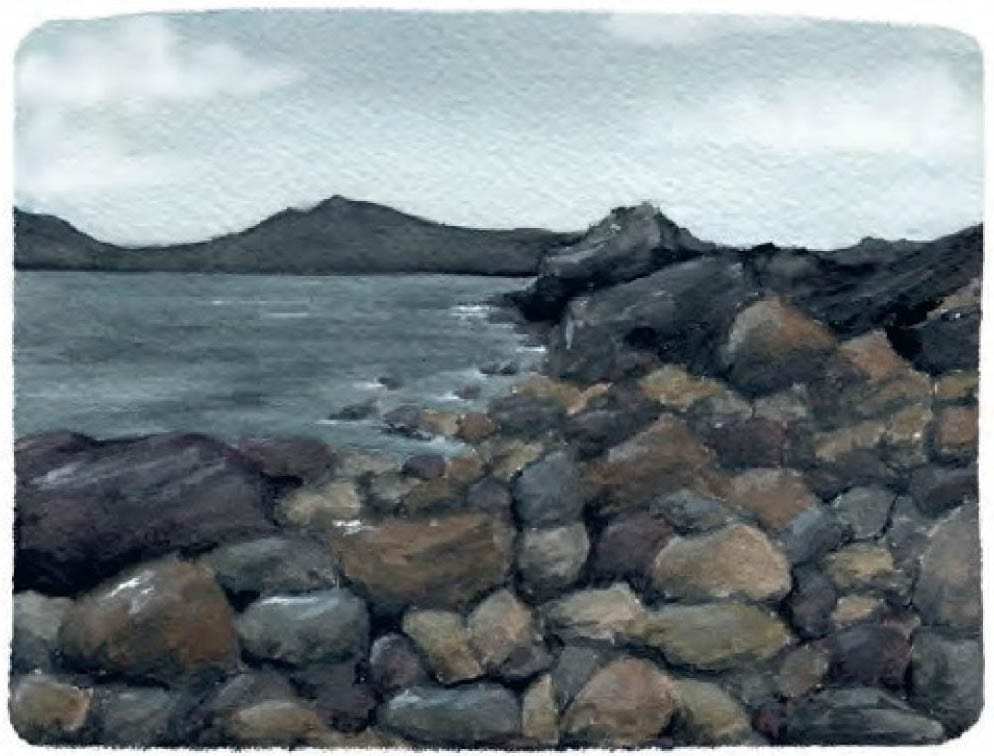
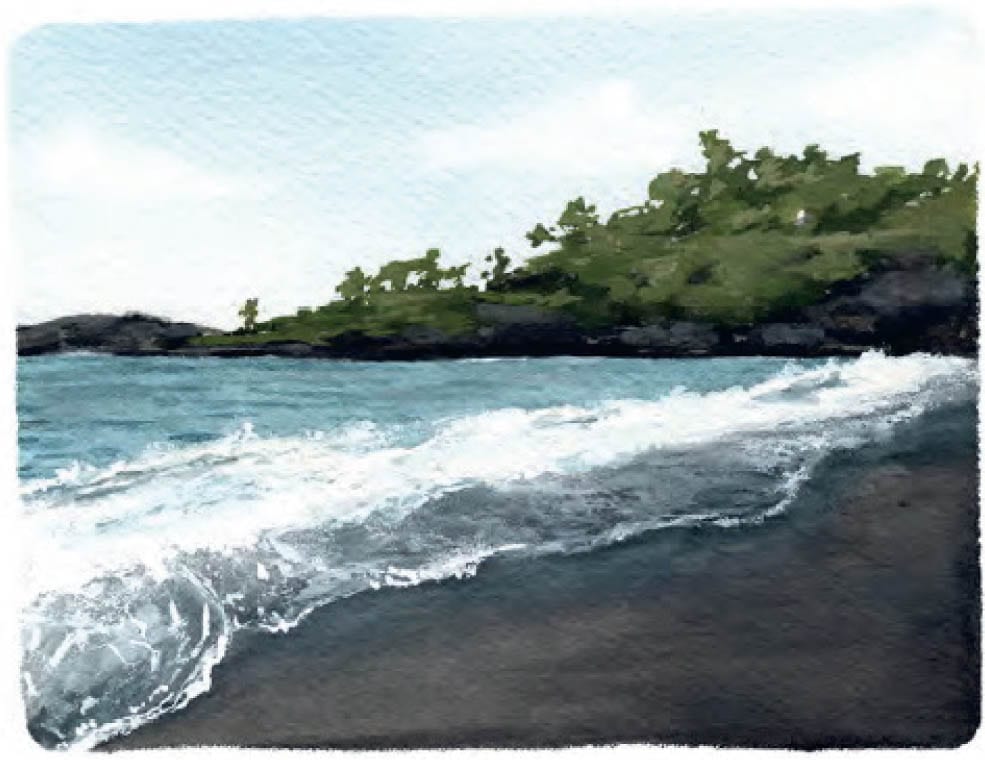
COASTAL LANDFORMS
Diverse and beautiful landforms develop around the seashore based on geography, weather patterns, and water movement. Because of this, seashores are ever-changing.
FUN FACT
Lagoons may form behind tombolos.
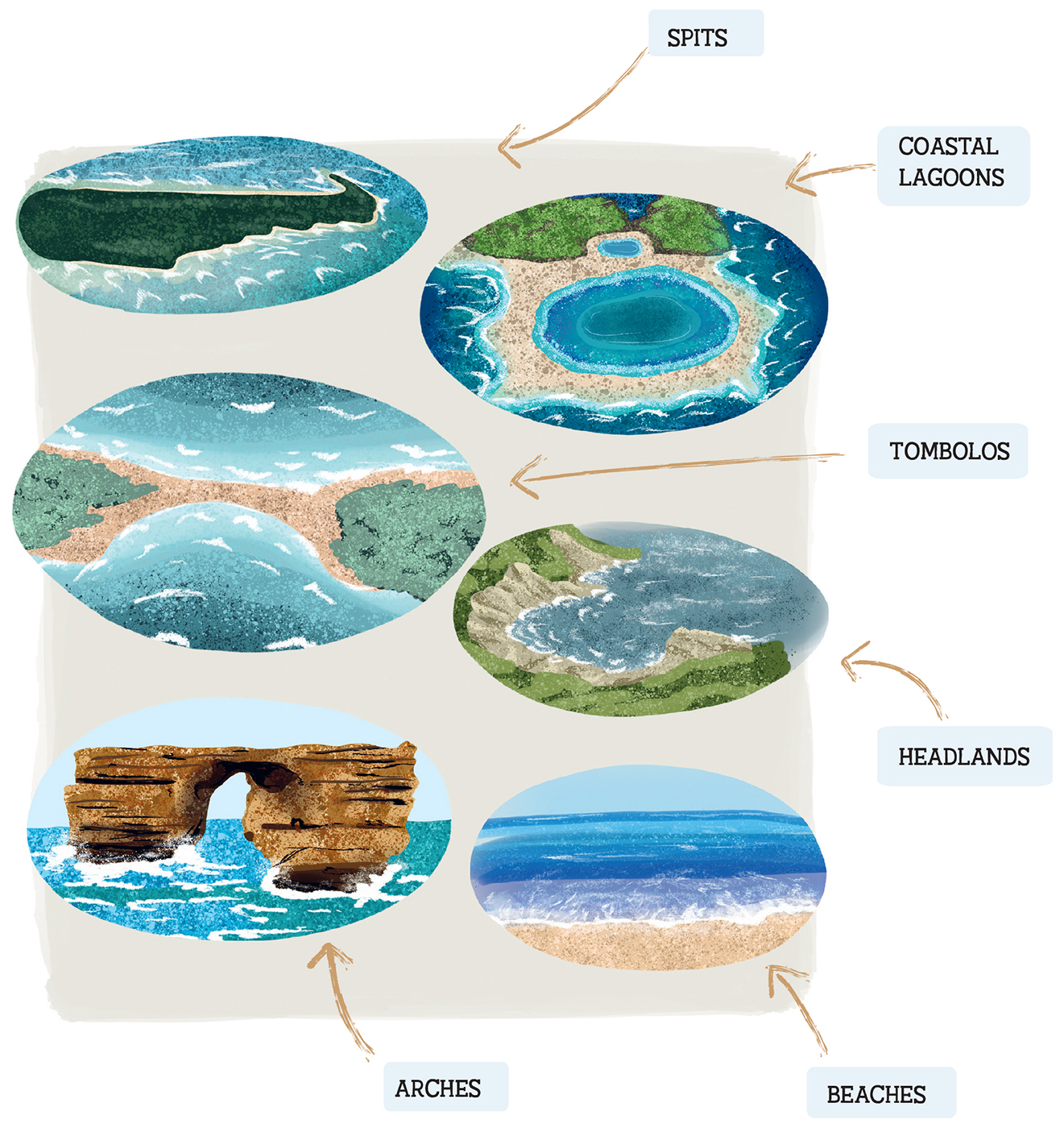
SPITS form through a process called longshore drift when winds blow in at an angle to the coastline, creating a drift of sediment in that direction.
COASTAL LAGOONS are shallow, protected areas of water that are fed by the ocean or rivers.
TOMBOLOS are spits that continue to form until they connect the mainland to an island, like a beach bridge.
HEADLANDS are created when the sea pounds away at the coast, and areas of softer rock are worn away. Bays usually form in the area where the rock was eroded.
BEACHES form when sediment, whether sand, mud, or rock, is carried in from another location.
ARCHES may form if caves in the headlands continue to wear away. Eventually, the arches will widen enough to collapse and form stacks.
The Sand Dune Ecosystem
Sand dunes are flourishing ecosystems! These dry beach areas support plant species like grasses and shrubs. Dunes store sand, and they help protect the coasts further inland from flooding. Burrowing animals can dig through the sand and take shelter in dunes. They feed on the vegetation and other animals there.
FUN FACT
Dunes form when seashore plants trap blowing sand.
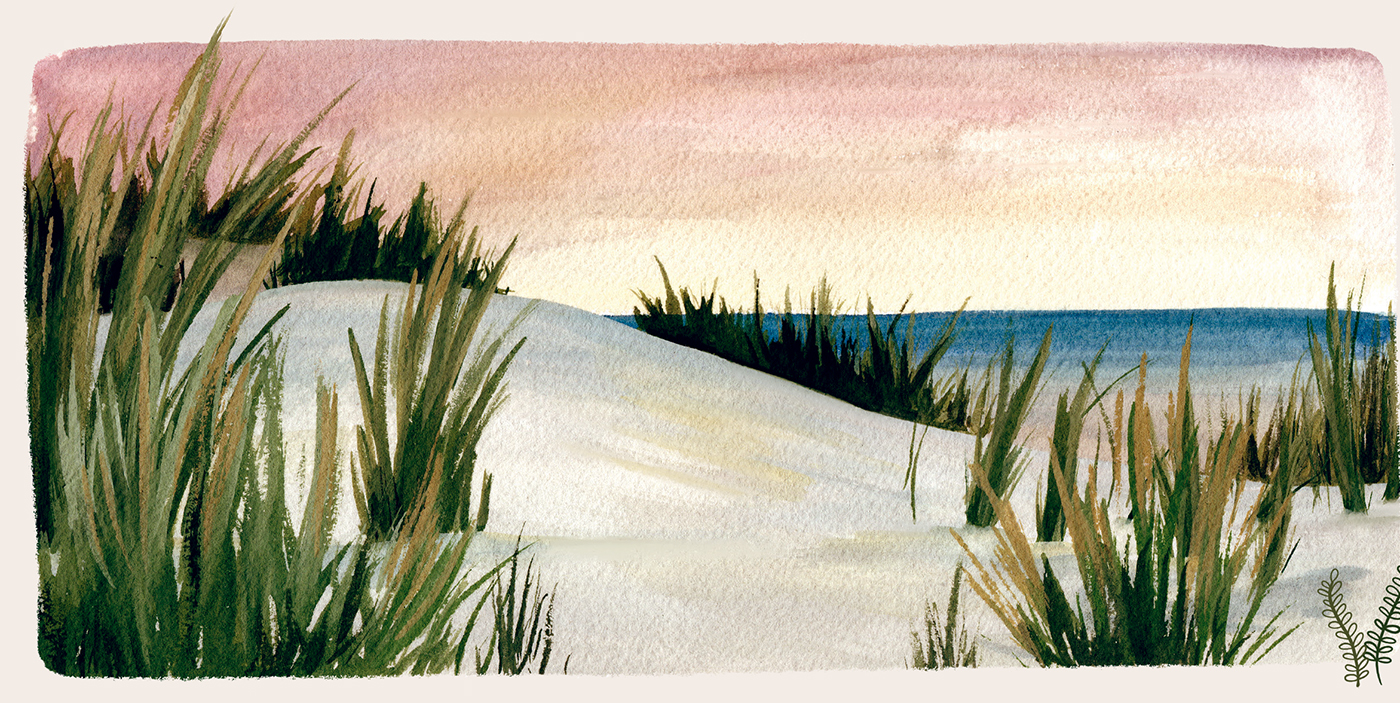
THE OCEAN
Covering more than 70 percent of Earth, the world’s salt water is divided into the Pacific, Atlantic, Indian, Arctic, and Southern oceans. They surround the world’s continents, forming smaller bays and inlets, estuaries, and lagoons along the coasts. The area just offshore called the coastal ocean is full of life!
FUN FACT
The water pressure in the hadalpelagic zone is too great to explore in much detail, and many mysteries are yet to be discovered at the bottom of the ocean.
Ocean Zones
The open ocean is divided into five major ZONES.

The EPIPELAGIC zone extends from the surface to about 650 feet (200 m). Sunlight allows for plants to photosynthesize, and most of the animal life scientists know about is found here.
The MESOPELAGIC zone reaches 3,300 feet (1,000 m) below the ocean’s surface. Very little light makes it dark, and the water temperature dips dramatically.
The BATHYPELAGIC zone reaches 2½ miles (4,000 m) deep. Also known as the midnight zone, no sunlight reaches this area. Fish in this zone have unique adaptations like bioluminescence.
The ABYSSOPELAGIC zone makes up approximately 60 percent of Earth’s ocean area. It stretches down 3¾ miles (6,000 m) below the water’s surface and lacks light, heat, and oxygen.
The HADALPELAGIC zone contains trenches carved into the ocean floor— may reach 36,000 feet (11,000 m) deep in some areas.
Water & Waves
An Elemental Look at Water
Ocean water contains many minerals that combine to form salts. These minerals are known as solutes, which are dissolved in ocean water.
WHERE DOES THIS SALT COME FROM?
RUNOFF from rain on land gathers minerals from rocks, drains into rivers, and eventually empties into the ocean.
VENTS in the ocean floor also contribute to Earth’s salty seas through chemical reactions that occur when water is heated by magma beneath the ocean floor.
Vast SALT DEPOSITS underground and under the sea floor also help make the ocean salty.
FUN FACT
The amount of salt in the ocean is called its salinity.

ANATOMY OF A WAVE
Energy travels through the salty ocean in waves, moving the water in a circular motion as the energy passes through. As the waves near the seashore, the gradual upward slope in the ocean floor slows the lower part of the wave. The top of the wave keeps moving and eventually breaks, crashing into the shore.
FUN FACT
Most waves are caused by wind blowing across the ocean’s surface.

THE TIDE
If you have ever visited the beach, you probably noticed the water level moving toward or away from you throughout the day. The movement of water inland and then back out is the tide. Twice each day, seashores experience high tides and low tides.
As the Moon revolves around Earth, its gravitational pull moves water toward it. The ocean water bulges toward the Moon on both the side of the Earth closest to the Moon and the opposite side, which causes high tides in those areas.
FUN FACT
As Earth rotates, different regions of the planet are affected by the tide.

Tidal Zones
Tides are important to seashore ecosystems because animals make their homes in the intertidal zone between the high and low tide points.

The SPLASH ZONE only receives some salty spray during high tide.
HIGH TIDE AREA at the top of the intertidal zone is covered in water only twice a day.
More plants and animals live in the MID-INTERTIDAL ZONE because it is covered in water for a good part of the day.
In the LOW TIDE AREA at the bottom of the intertidal zone, plants and animals must be adapted to living underwater nearly constantly.
The SUBTIDAL ZONE sits below the low tide line. Marine plants grow in this zone where sunlight filters through the water.
Tide Pool Habitat
Tide pools form in the intertidal zone and can be found on every type of beach, from smooth sand to jagged rocks. They form as the tide comes in and begins to fill up crevices and depressions in the seashore with water. Animals and plants living in tide pools must be adapted to living without water for some of the day.
Tide pool life is ever-changing, but with the right adaptations, animals can survive. For example, creatures must be able to hold on tightly to avoid being carried away by the ocean waves. Sea stars hang on to rocks with their tube feet, often hiding in crevices to avoid predators and the hot sun. Barnacles create a strong glue to hold on to the rocky tide pool walls, so crashing waves do not dislodge them.



FUN FACT
Pools closest to the high tide zone will not hold water for as long as those near the low tide end of the zone.
FUN FACT
Tide pool creatures like urchins, barnacles, and mussels have hard exoskeletons to protect them. Sea anemones draw in their tentacles, which helps seal in moisture. Some animals like crabs are able to move to more favorable areas when necessary.

SEASHELLS
Seashells are the exoskeletons of mollusks like clams, oysters, and snails. Shells protect their soft bodies from both predators and harsh conditions in their environment. Mollusks’ shells grow with them. They have an outer layer on their soft bodies called the mantle that makes the three-layered shell and connects the mollusk to it. The layer closest to the mollusk is smooth and shiny. The middle layer gives the shell its strength. And the outermost layer, made mostly of proteins, can be bumpy or ridged.
Empty seashells you find on the beach are left behind from mollusks that have died. Their shells may be reused by hermit crabs or broken up by the pounding waves and made into sediment that will be deposited on beaches or eventually formed into rock.
Among the most common shells you will spot on the beach are from bivalves. These two-part, hinged shells once belonged to clams, oysters, scallops, or mussels. Depending on the species, bivalve shells may be smooth or ridged, shiny or dull, plain or colorful.
FUN FACT
Shells are made up of minerals. Calcium carbonate is the mineral most abundant in seashells.
FUN FACT
Gastropods such as sea snails may leave behind whorled or spiral shells displaying a variety of colors and patterns.
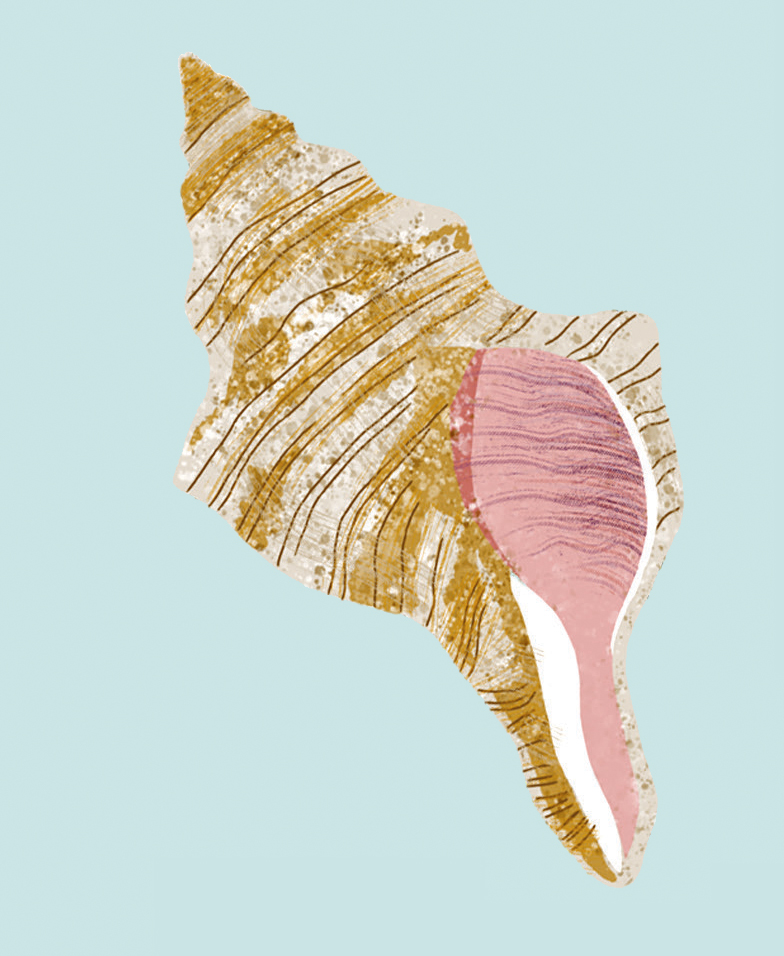
CONCH

SCALLOP

AUGER
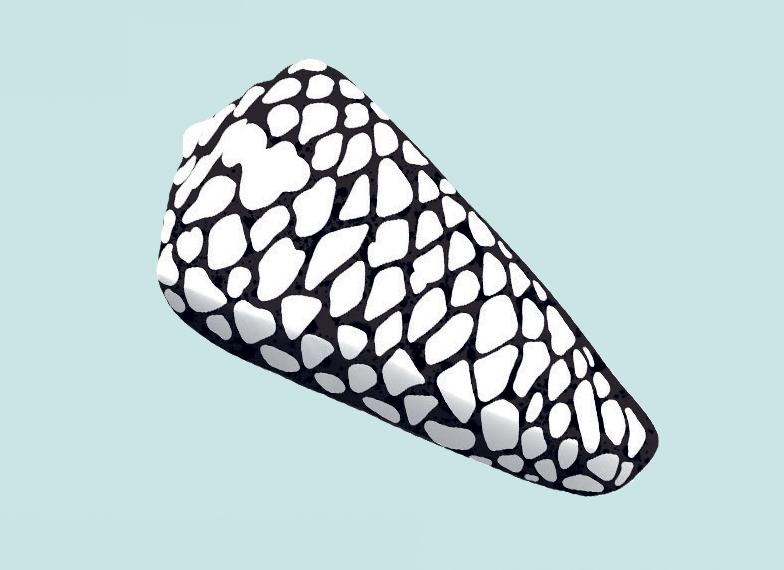
CONE

CLAM

TURRET

COCKLE
ATLANTIC OYSTER DRILLS are whelks that eat oysters and other invertebrates. They feed by drilling through the shell of their prey. They live submerged in water on the Atlantic coast of North America.
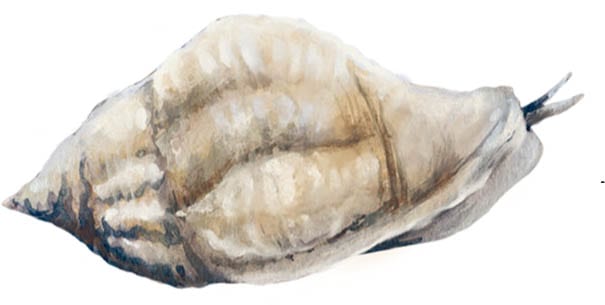
COMMON MUSSELS are native to the North Atlantic coasts of North America and Europe. They live in mussel beds surrounded by many mussels, filtering plankton from the water.

LIGHTNING WHELKS can reach a length of 16 inches (40 cm). They feed on bivalves like clams and oysters. They are native to shallow bays along the Atlantic coast of the United States and the Gulf Coast.

BAY SCALLOPS live around the world in grassy beds underwater, often in bays and harbors where they are filter feeders. Their shell has many eyes along the edge to detect predators.
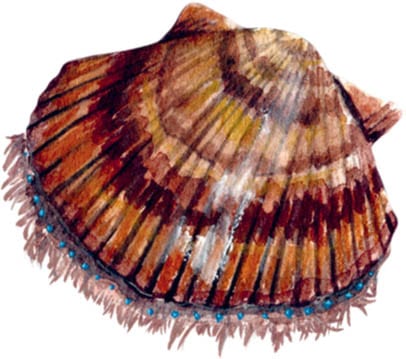
The EASTERN AUGER is a predatory snail that lives below the low tide zone of the Atlantic coast of North and South America. They are able to inject venom into their prey, marine worms.

Native to the Atlantic coasts of Europe and the Mediterranean, the WEDGE CLAM is a tiny species that buries itself in the sand. They prefer fine sand so they can hide quickly to avoid predators.

No Place Like Home
Hundreds of species of hermit crabs live around the world. This daring decapod is known for changing shells as it grows. It looks for a discarded shell to move into, most often a snail shell.
FUN FACT
Hermit crabs have a soft abdomen, hence the need for a shell to cover it.

ANIMALS
Seashores support living creatures, both large and small. Even tiny or microscopic creatures make their way to the seashore. Seashore animals must deal with the sun, salt, and surf. Waves may bounce them around or carry them out to sea. Life is definitely dynamic in this habitat where only the well-adapted survive.
FUN FACT
Plant plankton is called phytoplankton and animal plankton is called zooplankton.
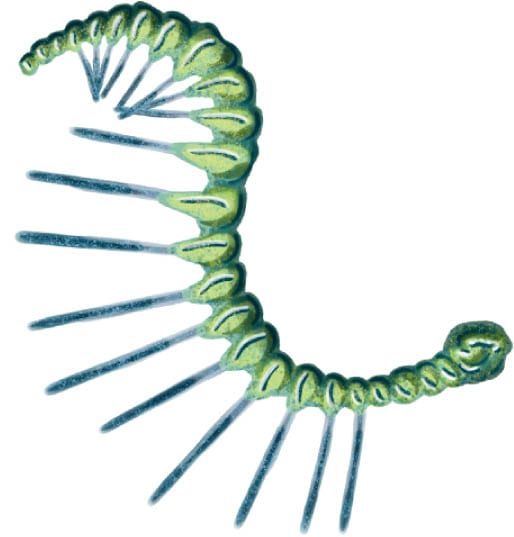
PHYTOPLANKTON

ZOOPLANKTON
Plankton, which can be microscopic, travel through the water with the currents and drift toward shore.
Seashore Visitors
Female sea turtles visit the seashore to lay their eggs on sandy beaches. Often these turtles will lay more than 100 small, round eggs in the sand before returning to the sea. When the hatchlings emerge in two months’ time, the tiny turtles will crawl through the sand toward their new ocean home.
FUN FACT
The seven species of sea turtles that live in our ocean waters are flatback, green, hawksbill, leatherback, loggerhead, Kemp’s ridley, and olive ridley.

The OCHRE SEA STAR inhabits the Pacific seashores of the western United States. They feed on mussels, snails, barnacles, and other small invertebrates as they cling to rocks in tide pools.

JELLYFISH are invertebrates that drift through the ocean and often float toward shore. Jellyfish sting predators as a defense and sting prey, such as fish and plankton, before digesting their meal.

SEA URCHINS live around the world’s oceans, often near the shore. Sea urchins have spines for protection and feed on algae using tooth-like structures.

Related to spiders and scorpions, HORSESHOE CRABS scuttle along the sandy shores of eastern North America and Southeast Asia. Their long telson is used to dig and right themselves if they get flipped over.

Over 1,000 species of SEA ANEMONES inhabit the world’s oceans. They attach themselves to rocks and other surfaces with a “foot.” Their venomous tentacles keep them safe and help them catch prey.

SAND DOLLARS feed on waste in the sand as well as algae and plankton. Sand dollars are able to bury themselves using their tiny spines to dig into the sand.

Octopuses
The common octopus is found around the world, often living in coastal waters of the Mediterranean and eastern Atlantic. Their camouflage changes with their surroundings.
FUN FACT
The common octopus squirts ink to distract predators while they make their escape.

COASTAL FISH
The diversity of fish in coastal habitats includes both large and small species. Tiny sculpins are adapted to get oxygen from the air when tide pool water levels drop. Leopard sharks adapted to feeding on a variety of fish found in the brackish waters of estuaries, which helps their species’ success. Eels use their long bodies to squeeze into crevices of coral reefs and ambush prey with their sharp teeth.
Despite their adaptations to different ocean habitats, fish actually share many characteristics.
- They are vertebrates and have an internal skeleton made of bone (or cartilage in the case of sharks and their relatives).
- They usually have gills to take oxygen from the water.
- They are often covered in scales.
- Most species are cold-blooded, or ectothermic, meaning their surroundings determine their body temperature.
FUN FACT
Some fish live in coastal habitats their entire lives. Others use them as nurseries for eggs and young fish or as feeding grounds.
Life Cycle of a Fish
FUN FACT
For some fish species, the fry stage may last up to a year.
A fish’s life begins as a tiny EGG, usually one of hundreds or thousands of eggs deposited by a female fish.
Under the right conditions, eggs will develop into LARVAE with a yolk sac attached for nutrients.
When larval fish begin finding their own food, they are called FRY. From fry, they become JUVENILES.
Fish are considered ADULTS when they are fully grown and are able to start the life cycle process all over again.

ROE (EGGS)

FRY

JUVENILE

ADULT MAHI-MAHI FISH
The COMMON BLENNY is found in coastal waters around Europe. Also known as the “sea frog,” it can survive out of water in rocky crevices or under wet plant cover.

ATLANTIC HERRING swim around the coastal areas of the North Atlantic. They feed on zooplankton, while larger fish and marine mammals make meals out of them.

The tiny ROCK GOBY swims the coasts of the eastern Atlantic and Mediterranean. They use their pelvic fins to create suction to hold them onto rocks as the waves move in and out of the rocky shore.

As SOUTHERN STINGRAYS swim across the sandy ocean bottom along the coasts of the western Atlantic, they find prey by using electroreception as well as their senses of taste and smell.

Along the shallow coasts of southern Australia, the ZEBRAFISH swims around rocky areas and estuaries feeding mostly on algae.

The SIX-FINGER THREADFIN inhabits the warm, shallow coastal waters around the islands in the Indian and Pacific oceans.
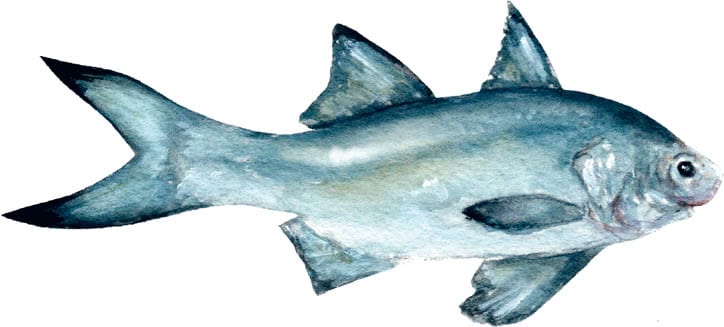
Seahorses
Seahorses swim in an upright position, using their dorsal and pectoral fins to move. Hard plates protect their body, and their tail wraps around vegetation to keep them from floating away while they’re feeding on tiny animals in the water.
FUN FACT
A female seahorse lays her eggs in the male’s pouch, where he fertilizes and incubates the eggs.

PREDATORY FISH
Microscopic phytoplankton by the billions, along with seagrasses, other plants, and kelp, create the base of the ocean food chain. Creatures like manatees, shrimp, and mollusks feed on these plentiful producers. Smaller meat-eaters, like herring and cod, eat small creatures. Large fish and other sea creatures are on the menu of apex predators like sharks, tuna, and billfish.
FUN FACT
You can thank the ocean’s top predators for keeping the ecosystem in balance.
Seashore Food Chain

Predator Adaptation: Teeth
As top predators in the ocean, sharks have teeth adapted to help them grasp and eat their prey.
- Sharks that feed on shelled crustaceans, mollusks, and bivalves often have flatter teeth for grinding.
- The largest sharks of all, which are filter feeders, have small teeth they rarely use.
- Wide, serrated teeth are usually found in sharks that eat large animals they must first tear apart.
- Other sharks have longer, pointed teeth. Like tiny swords, they pierce and hold the prey before the shark swallows its meal.
FUN FACT
Because sharks have teeth that are not solidly anchored in bone, they may go through up to 30,000 teeth in their lifetime.
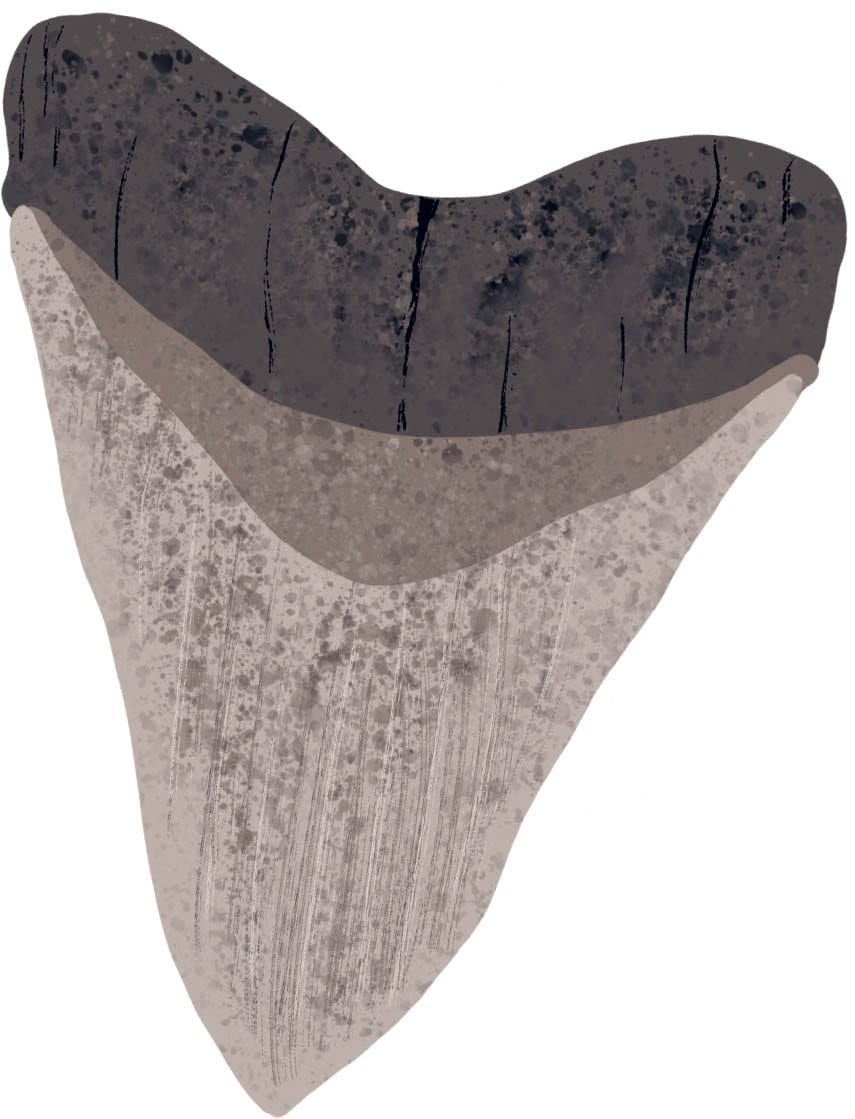
Shaped like torpedoes, BARRACUDAS move through the water with ease, looking for prey such as jacks, snappers, and even groupers. Barracudas live in warm coastal waters around the world.

MALABAR GROUPER are found in tropical waters of the Indian and western Pacific oceans. They hunt alone, sucking up food from the bottom, like fish, crustaceans, and even cephalopods.

BLUEFIN are the largest of the TUNA species, growing up to 16½ feet (5 m) in length and weighing nearly 3,750 pounds (1,700 kg)! They speed through subtropical and temperate waters looking for fish to feed on.

The GIANT TREVALLY patrols the tropical coastal waters of the Indo-Pacific looking for fish to eat. The giant trevally is the largest trevally species, occasionally reaching lengths close to 6½ feet (2 m).

Shark!!!
Like many shark species, tiger sharks’ bodies are darker on top than on the bottom. This countershading makes it difficult for fish to see them coming from above or below.
FUN FACT
Tiger sharks may grow over 20 feet (6 m) in length and reach a weight of nearly 2,000 pounds (900 kg).

MARINE MAMMALS
Many marine mammals can be observed from shore. This diverse group of creatures includes mammals that live their whole lives in the ocean, such as whales and dolphins. With streamlined bodies, they travel in family groups. They have speed to catch prey and blowholes to breathe air as they surface while swimming. Some marine mammals such as seals and walruses spend time in the sea but come ashore to rest and raise their young.
FUN FACT
Marine mammals have hair on their bodies at some stage of their life, breathe air through lungs, make milk to feed their babies, and are warm-blooded (endothermic).
Dolphin vs. Shark Fin
When viewing from shore, you will notice dolphins’ dorsal fins are shaped like an ocean wave, slightly rounded with a curved rear edge. Sharks’ dorsal fins are more triangular in shape.

Whale Watching
To spot cetaceans (whales and dolphins) from shore, begin by slowly scanning the ocean. Watch for spouts of water going upward. You might get a peek at dorsal fins and flukes emerging from the water. Large splashes in the water may indicate a whale has breached, and smaller splashes could mean a pod of dolphins is offshore.

Traveling at speeds of 18 miles per hour (29 kph), BOTTLENOSE DOLPHINS zip around temperate and tropical coastal waters in addition to bays, harbors, and estuaries. They use echolocation to locate prey.

MANATEES are herbivores, eating seagrasses in shallow coastal waters. They swim slowly, using their tails to propel them. Manatees grow up to 13 feet (4 m) long and can weigh up to 1,200 pounds (540 kg).

The intelligent ORCA is the largest member of the dolphin family. They often inhabit cold coastal waters around the world’s oceans. Orcas hunt in groups, feeding on fish and marine mammals.

SEA OTTERS are found in shallow coastal waters of the Pacific Ocean near North America and Asia. They spend time in kelp forests and estuaries feeding on sea urchins, octopuses, and shellfish.

HUMPBACK WHALES swim in coastal waters of all the world’s oceans. They are baleen whales that filter krill and small fish from the water. They communicate with each other through elaborate songs.

SEA LIONS inhabit the coasts of the Pacific Ocean. They are speedy swimmers that dive for fish and squid. They congregate in harems on sandy beaches during the breeding season to raise their pups.

Walruses
Walruses are huge, hairy pinnipeds that live in the Arctic Ocean and surrounding seas. Walruses use rocky shores and sea ice for resting and breeding grounds. They feed in shallow waters, eating shellfish and occasionally scavenging.
FUN FACT
Walrus tusks are actually large canine teeth, and both male and female walruses have them.

BIRDS
Birds at the seashore fill different niches to avoid competing with each other for food in their coastal ecosystem. Shorebirds are usually carnivorous species that feed on fish, mollusks, and crustaceans on the beach and in shallow coastal waters. They are social creatures, with different species flocking together at times.
FUN FACT
Many shorebirds are camouflaged, so they stay hidden when looking for food or incubating eggs in their nests on the ground.
Bird Beaks

FISHING (TERN)

SURFACE SKIMMING (BLACK SKIMMER)

INSECT EATING (PIPING PLOVER)

SCAVENGING (SEAGULL)

DIP NETTING (PELICAN)
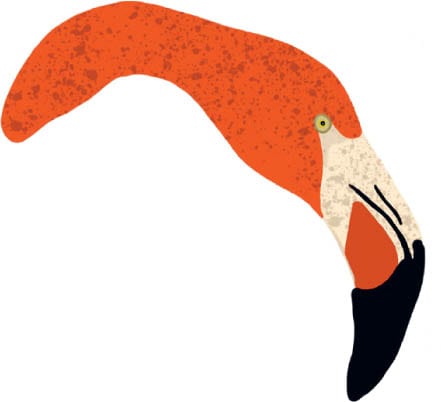
FILTER FEEDING (FLAMINGO)
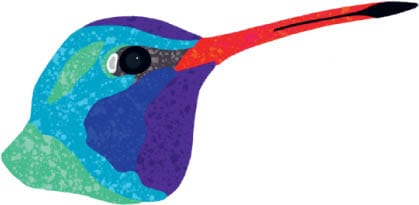
NECTAR FEEDING (HUMMINGBIRD)
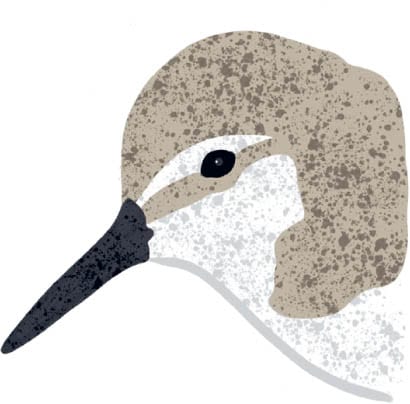
MUD PROBING (SANDPIPER)

RAPTORIAL (PEREGRINE FALCON)
Some beaks work like tweezers to reach food in the sand or mudflats.
The shape and features of bird beaks are adapted for specific diets.
Super sturdy beaks pry open mussel shells or turn over rocks to look for food.
Bird beaks are covered in keratin for protection and have two parts, the upper and lower mandibles. Similar to your jaws, the upper mandible doesn’t move, but the lower mandible does.
Large spoon-shaped beaks take in water and filter out small invertebrates.
Pelicans have expandable beaks to scoop fish from the sea.
Birds also use upturned beaks to stir up sand and expose a buffet of buried invertebrates.
Raptors along the coast have hooked beaks for tearing large prey apart.
BROWN PELICANS live in coastal areas around North America, the Caribbean, and parts of Central and South America. They dive to the water’s surface to grab fish and carry them away in their large gular pouch.
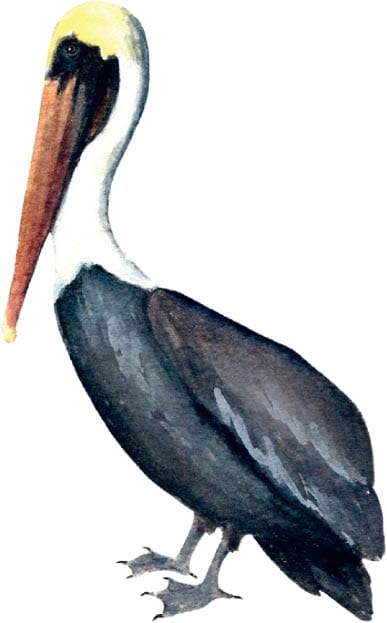
Along the Atlantic coast of North America, the PIPING PLOVER roams sandy beaches, running rapidly and stopping when it sees a morsel to eat, such as a worm, insect, or crustacean.

AMERICAN AVOCETS frequent the coasts of the United States and Mexico. They use their long beak to find food as they swing their head back and forth, allowing their beak to touch the water and sand.

BLACK-NECKED STILTS spend their time foraging in mudflats, lagoons, and salt marshes of North, Central, and South America. There they feed on insects, crustaceans, fish, amphibians, and vegetation.

SANDERLINGS are known for chasing waves on sandy shores looking for crabs. Their breeding season is spent nesting in North America, Europe, and Asia in regions near the Arctic.

BLACK SKIMMERS of North and South America are known for their uneven bill. They fly over the water, skimming the surface with the lower mandible and quickly biting down when they sense fish to eat.

Gulls
Common beach residents around the world, gulls feed on many species of fish and invertebrates while their eggs and young provide food for larger animal predators. With long, narrow wings, gulls are quick fliers.
FUN FACT
Gulls have webbed feet for paddling in the water.

PLANTS
Seagrasses and kelp, which are brown algae, grow around the world’s coastal waters, feeding creatures and sheltering animals. Marine plants and kelp have roots to anchor them or structures that wrap around rocks to keep them from floating away. Coastal plants have to deal with salty sea spray, sandy soil, and harsh winds. Many of them are low to the ground and have small leaves to keep them from losing water.
FUN FACT
Kelp and other algae are similar to plants, but they are actually protists.
Kelp Forests
Kelp forests develop in shallow waters where sunlight helps them mature rather quickly. Kelp forms canopies of fronds that rest on the ocean’s surface. These huge forests support a diverse collection of marine species, such as sea urchins, snails, fish, and marine mammals.
FUN FACT
Kelp can grow up to 20 inches (50 cm) per day in favorable conditions.

With serrated fronds, TOOTHED WRACK is a brown seaweed that grows on Europe’s Atlantic coast and the Atlantic coast of northeastern North America. It offers shelter to invertebrates on rocky shores.
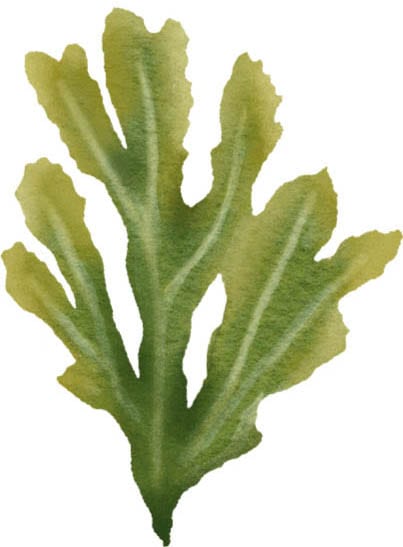
FEATHER BOA KELP is a seaweed that grows in turbulent coastal waters along North America’s Pacific coast. It can reach lengths of 33 feet (10 m), and it is eaten by kelp limpets.
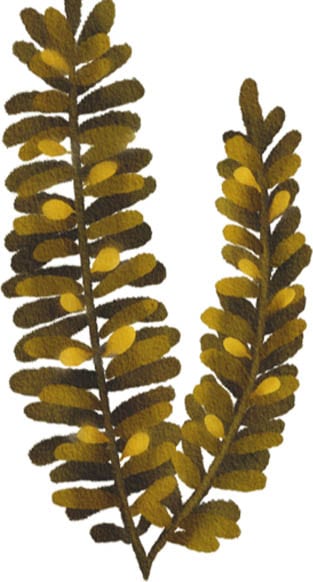
BEACH BEAN is a vine that helps prevent sand erosion along tropical coasts. Its yellow flowers develop throughout the year, and its fruit grows in a pod like peas.

ASIAN SURFGRASS grows in large “fields” on northeastern Asia’s rocky shoreline. It reproduces using rhizomes, which are like stems that grow horizontally underground.

Beautiful reddish pink flowers of RED SAND VERBENA stand out against its green, salt-storing leaves. It’s found in sandy areas of the California coast in North America, where it provides cover for wildlife.

EUROPEAN BEACH GRASS is native to Europe and parts of Asia but has been introduced to many regions of the world. The plant forms dense clumps of grass that trap sand and build up dunes on beaches.

Anatomy of Kelp
Kelp is a type of brown algae or seaweed that grows in shallow, cold, coastal waters. Although they are not plants, they are able to photosynthesize and have structures similar to those of plants.
FUN FACT
Kelp do not have roots, but rather holdfasts that anchor them to rocks.
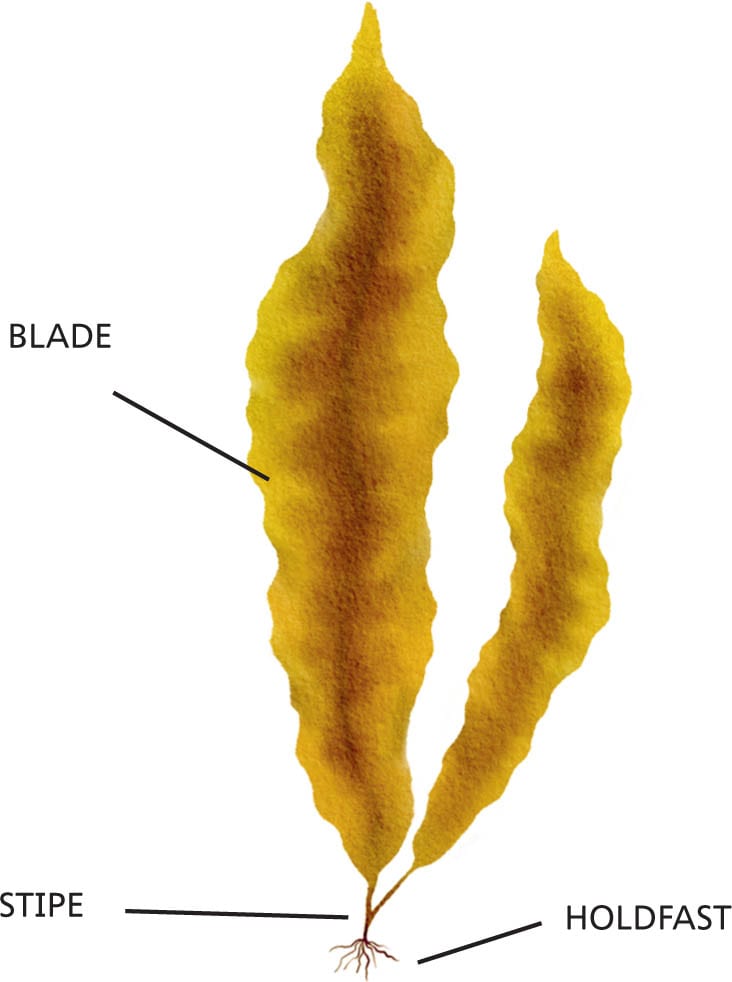
ACTIVITIES
You have walked the world’s seashores and examined this extraordinary ecosystem from the tiniest plankton to the largest coastal predators. In this section, you will find a collection of activities related to your understanding of this part of the ocean biome.
Nature Journal
Using your nature journal or notebook, take a walk along the seashore for inspiration. Create a landscape sketch or watercolor in your journal. Or you might choose to journal something more specific, such as a seashell you find, a plant nearby, or a creature you see in a tide pool. Be sure to include the location, date, time of day, and weather conditions. If you do not live near the seashore, use a photo or even a nature find from a previous visit. Alternatively, you could journal about a coastal creature or plant from a book or documentary.
Salt Painting
We discovered that salt is dissolved in ocean water, but salt is also a fun material to use in art projects! You’ll need white glue, cardstock or cardboard, a pencil, table salt, a dropper or pipette, liquid watercolor or water with food coloring, and water.
Squeeze glue into a picture or an abstract design on your cardstock or cardboard (you can draw a design with pencil beforehand).
While the glue is wet, pour salt over it so the salt sticks to the glue.
Once the glue is dry, use the dropper to add watercolors along the salt lines. The salt will absorb your paint and make a beautiful raised design on your paper.

Salt Dough Seashells
Using your favorite salt dough recipe, mix up a batch and use it to make seashell art! You can roll out a section of dough and use it to make impressions with the seashells. Press them firmly into the dough, and then remove them to see the patterns they leave behind. Bake the salt dough to preserve these molds, or roll it back out again and choose different shells to make new impressions. Use your finished project as a piece of art or a paperweight. Additionally, you can form the salt dough into your favorite seashell shape and make a salt dough seashell collection.
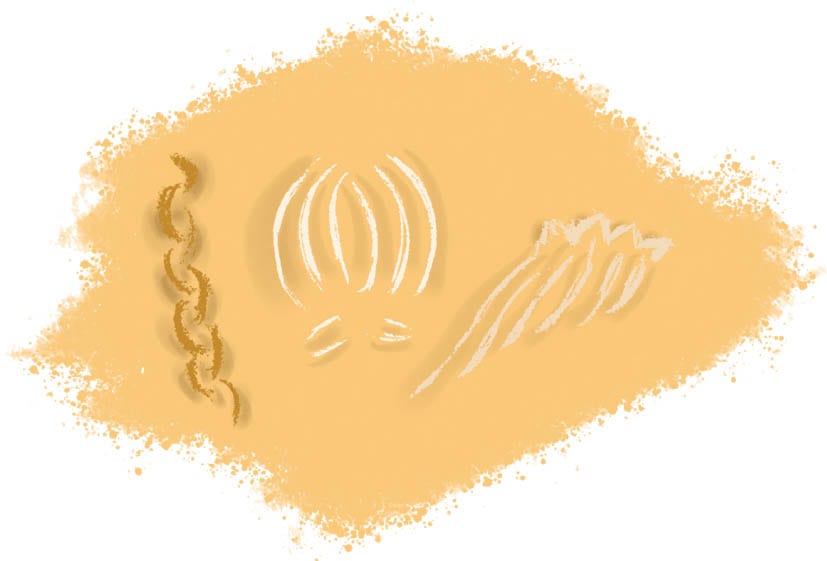
Ocean in a Bottle

We learned about the different layers of the ocean from the sunlit epipelagic zone to the darkest hadalpelagic zone. Let’s create a model of these layers using corn syrup, food coloring (blue, green, and red), a bowl, a spoon, a recycled water bottle or jar, dish soap, water, vegetable oil, and rubbing alcohol. A funnel will help you pour in the ingredients, so the layers form properly and do not touch the edges of the jar.
- 1. Mix 1 cup (240 ml) of corn syrup with drops of blue, green, and red food coloring until it turns black. This will represent the deepest part of the ocean and the hadalpelagic zone. Add it to your bottle using the funnel.
- 2. Clean the bowl, and then add 1 cup (240 ml) of dish soap along with red and blue food coloring to make a dark purple. Mix and then, using a clean funnel, add this layer next. It will represent the abyssopelagic zone.
- 3. Clean the bowl, and add 1 cup (240 ml) of water along with several drops of green food coloring and one drop of blue. Mix it together, and add it to the bottle with a clean funnel. This represents the bathypelagic zone.
- 4. Clean the bowl, and add 1 cup (240 ml) of vegetable oil along with several drops of blue food coloring. Mix it together, and add it to the bottle with a clean funnel. This layer represents the mesopelagic zone.
- 5. Clean the bowl once more, and add 1 cup (240 ml) of rubbing alcohol. Mix in one or two drops of blue food coloring, and add this layer to the bottle using a clean funnel. This represents the upper, sunlit layer of the ocean, the epipelagic zone.
- 6. In addition, you can create labels for your different layers or make a key on paper to go with it.
On the Beach
Beachcombing is simply walking along the beach and looking for shells, shark teeth, sea glass, and other interesting items that have washed up on shore. After a storm or when the wind is strong is one of the best times to check out what the waves have brought in. If the area where you’re beachcombing allows, you can even take some treasures home with you. While on the beach, be sure to look toward the ocean as well. Dolphins, sharks, manatees, and whales are sometimes visible from the beach.
BEACHCOMBING

SAND DOLLAR

SHARK TOOTH

SEA STAR
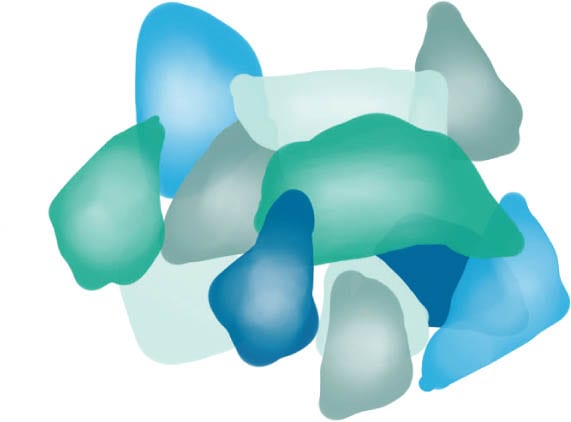
SEA GLASS
SEASHELLS

BANDED TULIP

WENTLETRAP

COFFEE BEAN TRIVIA

ABALONE

SCALLOP

MARBLED CONE

COCKLE

WORM SNAIL
FINS AND FLUKES

DOLPHIN DORSAL FIN

HUMPBACK WHALE FLUKE

MANATEE FLUKE

ORCA DORSAL FIN

DOLPHIN FLUKE

WHITE-TIPPED REEF SHARK DORSAL FIN

BLACK-TIPPED REEF SHARK FLUKE
Seashore Scavenger Hunt
On your next visit to the seashore, test your observation skills and senses as you find the items on this list! If you don’t live near the seashore, go to a lake, pond, stream, or wetland instead, and adapt the items to your region. If you’re not able to get outdoors, you can always use your imagination to complete this scavenger hunt inside!
- A tiny shell
- Something swimming
- Sand
- Footprint
- Bird calling
- Piece of trash (be sure to throw it away!)
- Seaweed or seagrass
Did You Know?
Sandy shores make some of the most beautiful beaches on Earth. From soft sand to pebbles, beaches form when rocks are broken down over time. Wind and water constantly pounding against rock wears it down into smaller rocks and eventually sand. The water also carries pieces of rock far away and deposits them in a new location, especially when storms make landfall. Troughs and sand bars may be created offshore by the moving water. Plants and other debris wash up on shore with the waves.
